
Students will be able to identify and write in different poetic formats.
- Subject:
- English Language Arts
- Material Type:
- Lesson Plan
- Provider:
- Education.com
- Author:
- Elizabeth S. Tyree
- Date Added:
- 02/26/2019

Students will be able to identify and write in different poetic formats.

In this lesson, students read and analyze the poem, Richard Cory by Edwin Arlington Robinson. Students consider how the poem reflects reality in its treatment of celebrity in discussion and graphic organizers.
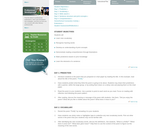
In this lesson, students will use a weekly poem to explore meaning, sentence structure, rhyming words, sight words, vocabulary, and print concepts. After studying the poem, students are given a copy of the poem to illustrate and share their understanding. All of the poems explored are then compiled into a poetry portfolio for students to take home and share with their families. To further connect home to school, a family poetry project is suggested.
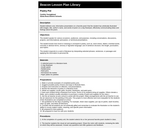
For this lesson, students deliver an oral, informative presentation on a favorite poem that the he/she has artistically illustrated with images, title, author's name, and words of poem on a clay flowerpot, effectively communicating ideas and feelings about the poem.
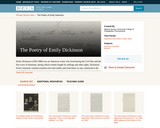
This collection uses primary sources to explore the poetry of Emily Dickinson. Digital Public Library of America Primary Source Sets are designed to help students develop their critical thinking skills and draw diverse material from libraries, archives, and museums across the United States. Each set includes an overview, ten to fifteen primary sources, links to related resources, and a teaching guide. These sets were created and reviewed by the teachers on the DPLA's Education Advisory Committee.
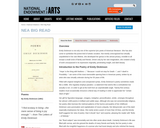
Although virtually unknown during her life, this visionary New England poet is now praised as one of America's most original writers. The Big Read Readers Guide deepens your exploration with biography, timelines, and historical information. We hope these educational materials allow you to have fun with your students while introducing them to the work of a great American poet.
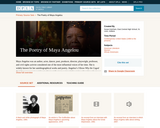
This collection uses primary sources to explore the poetry of Maya Angelou. Digital Public Library of America Primary Source Sets are designed to help students develop their critical thinking skills and draw diverse material from libraries, archives, and museums across the United States. Each set includes an overview, ten to fifteen primary sources, links to related resources, and a teaching guide. These sets were created and reviewed by the teachers on the DPLA's Education Advisory Committee.
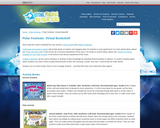
This article features activity books and polar-themed children's literature for use in the elementary classroom.
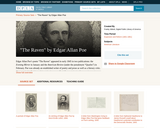
This collection uses primary sources to explore Edgar Allan Poe's "The Raven." Digital Public Library of America Primary Source Sets are designed to help students develop their critical thinking skills and draw diverse material from libraries, archives, and museums across the United States. Each set includes an overview, ten to fifteen primary sources, links to related resources, and a teaching guide. These sets were created and reviewed by the teachers on the DPLA's Education Advisory Committee.
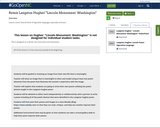
Lesson covers several kinds of figurative language, especially omission.

This lesson encourages students to reflect on personal tragedy by examining how others reacted to the terrorist attacks on 9/11. Students examine some poems written after the attacks before composing their own post-tragedy poems.

In this lesson, students examine Anglo-Saxon poetry riddles to learn about the Anglo-Saxon culture and people. Students then craft their own riddles to try to fool their classmates.

In this lesson plan, students discuss and analyze Robert Frost's poem Acquainted With The Night. Students read the poem together before analyzing its use of repetition, personification, and metaphor, and examining its potential themes.
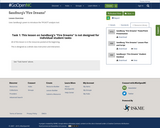
Uses Sandburg's poem to introduce the TPCASTT analysis tool.
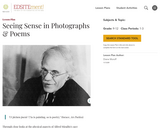
This lesson helps students become more familiar with poetry concepts by using photography to jumpstart the critical thinking process. Students compare photographs to poetry after recording their reactions to each.
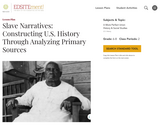
The realities of slavery and Reconstruction hit home in poignant oral histories from the Library of Congress. In these activities, students research narratives from the Federal Writers' Project and describe the lives of former African slaves in the U.S. -- both before and after emancipation. From varied stories, students sample the breadth of individual experiences, make generalizations about the effects of slavery and Reconstruction on African Americans, and evaluate primary source documents.
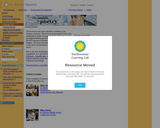
This lesson plan is designed to introduce students to the rhythms of poetry. The lesson focuses on two poetic forms: the Ballad stanza and the Blues stanza. Lesson includes notations to incorporate poetry analysis and recitation. The lesson also involves practice skills to recognize and understand poetic structures such as: iambs, measures and rhythm. It includes a link to applicable music files.
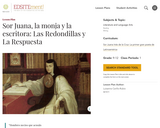
Sor Juana Inés de la Cruz, la primer gran poeta de América Latina, es considerada una de la figuras literarias más importantes del continente americano y una de las primeras feministas. En el siglo XVII, defendió su derecho a la educación, proponiendo la mayor participación de las mujeres en la cultura y la pedagogÃa en una sociedad dominada por los hombres.
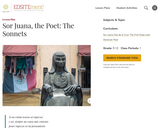
Students will be able to understand how the historical and cultural contexts influence literary creation. Students will identify and effectively analyze sonnets of the Spanish Golden Age in Spanish. Furthermore, students will listen, comprehend, read and analytically write about poetry in Spanish.
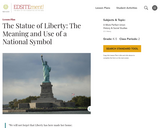
Help clarify the nature of symbols for your students as they study the Statue of Liberty, complete research on a national symbol, and use their research to communicate a message of their own.